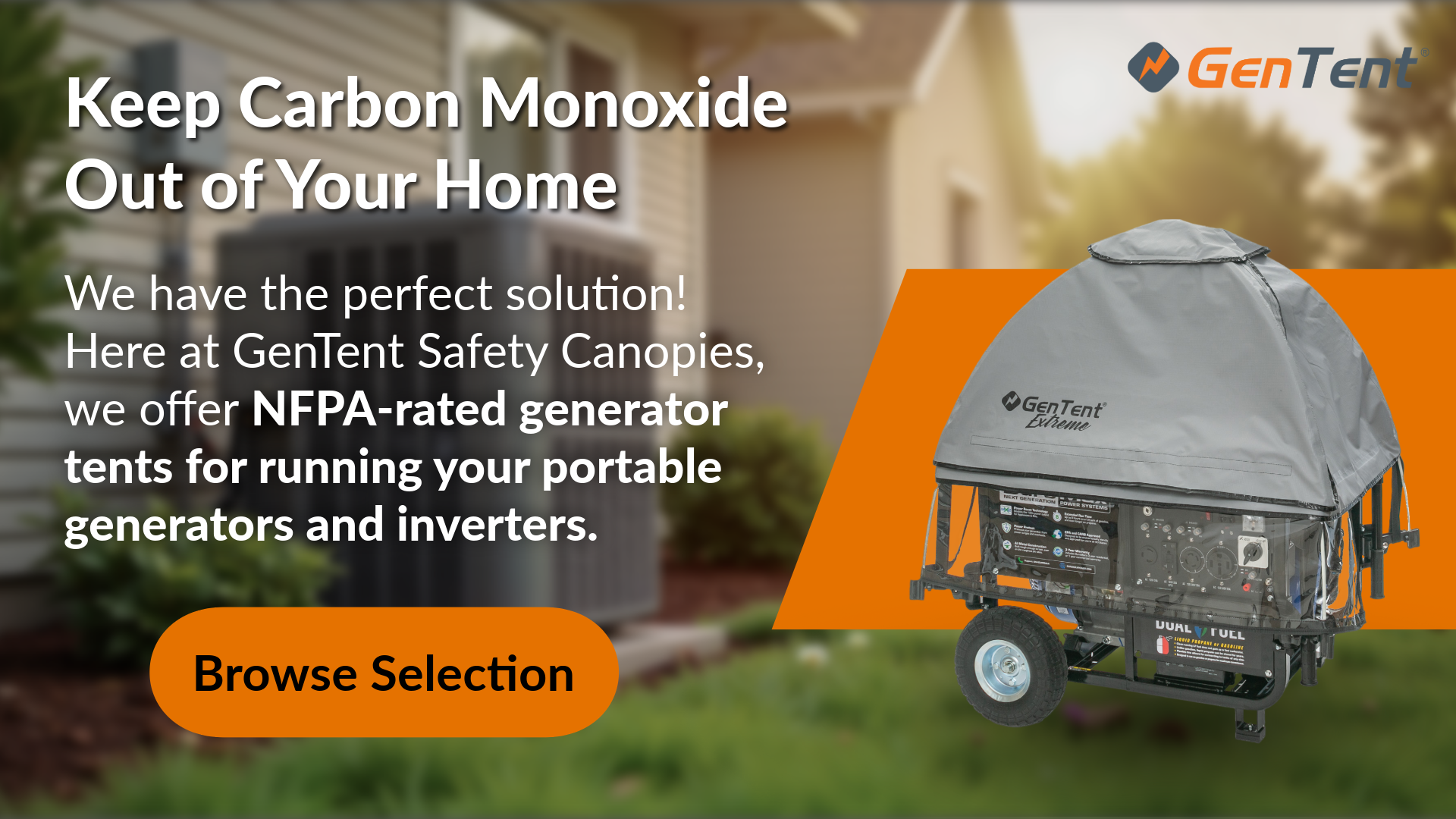How Far Should a Portable Generator Be from Your Home?
Posted by Saloni Mahapatra on Jul 28th 2025
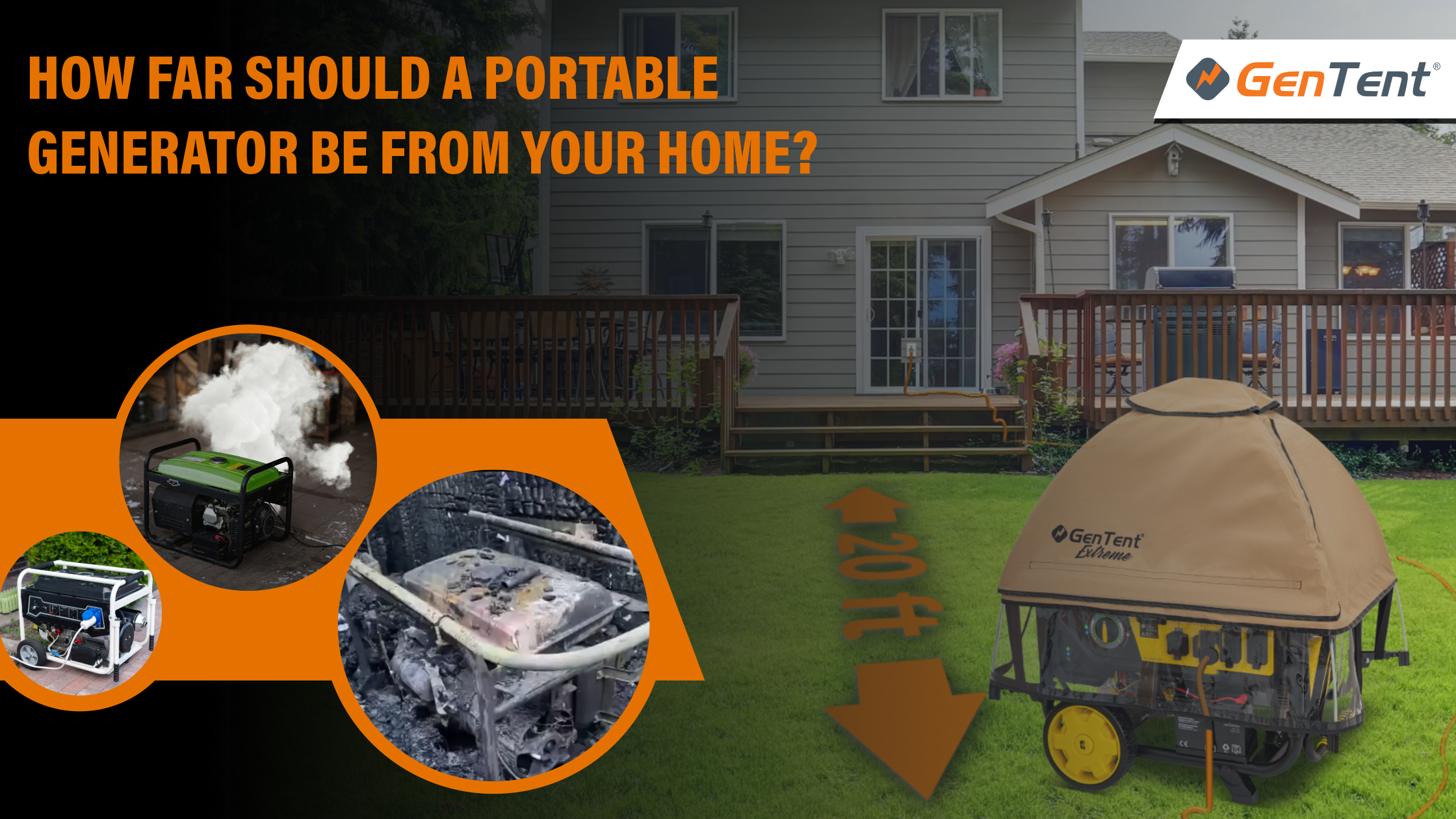
Power outages are becoming more frequent, whether from hurricanes, ice storms, or an aging electrical grid. When the lights go out, a portable generator can be a lifeline, keeping your essentials running and your family safe and connected.
But here’s the catch: placing your generator in the wrong spot can turn that solution into a deadly risk. Despite the seriousness, and the rise in CO injuries and fatalities (as reported by CPSC), most guidance still uses vague terms like “a safe distance,” leaving users to interpret what that actually means.
This blog clears up the confusion. We’ll walk through the precise distance your generator should be from your home, why it matters, and how generator running covers like GenTent can help you operate your generator safely in any weather. We also provide a helpful Generator Safety Checklist at the end of this blog to help you always run your generator outside safely.
What are the Hazards When Using a Portable Generator?
A portable generator is a machine powered by gasoline, propane, diesel, or natural gas that makes electricity. While people use portable generators in many instances: camping, construction sites, tailgating, etc.; people most commonly use them during blackouts caused by storms, hurricanes, or winter weather. According to the Consumer Product Safety Commission (CPSC), portable generators are responsible for the largest number of carbon monoxide deaths among engine-driven tools.
Carbon monoxide isn’t the only danger. Safety professionals also warn about fire hazards; like flammable surfaces, dry vegetation, or spilled fuel, that add another layer of serious risk. And with recent changes to generator design that can affect operating temperatures, maintaining distance from combustible materials is more critical than ever.
Portable generators are great for powering your home in an emergency, but they must be used safely and correctly.
Portable Generators Produce Dangerous Carbon Monoxide Gas
Every gas-powered generator releases carbon monoxide (CO), known as “the invisible killer”—a colorless, odorless gas that can be deadly within minutes if it builds up indoors. While this gas is dangerous for adults, it’s even more lethal for children and pets.
According to the National Institute of Standards and Technology (NIST), a single generator creates “as much as 100 times more poisonous carbon monoxide gas than a car's exhaust.”
When generators are placed too close to a home, CO gas can enter through windows, doors, vents, or cracks. These dangers increase when the air is calm and the gas lingers nearby due to limited airflow, and during cold weather when CO density increases.
The Centers for Disease Control and Prevention (CDC) conducted testing and found that nearly half of non-fatal CO poisonings during hurricanes were linked to generators used within 7 feet of a home.
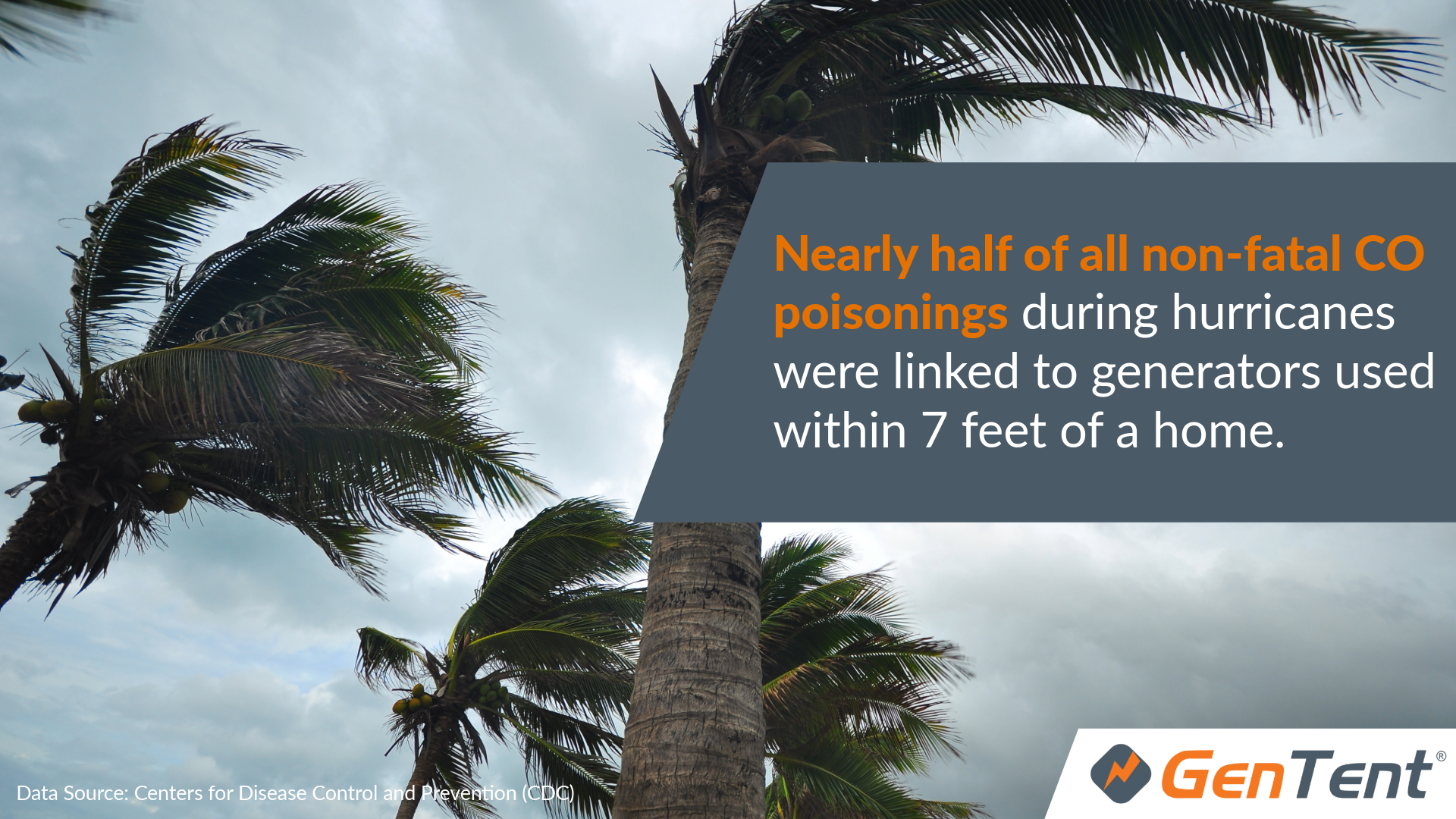
How Carbon Monoxide Enters the Home
To find out just how carbon monoxide spreads, NIST and the CDC created a one-story model home and ran detailed simulations. They placed a generator outside and studied how CO moved with different wind speeds.
Their tests showed:
- Even 15 feet away wasn’t far enough placement for generators. CO was still entering the house at unsafe levels, especially when wind was calm.
- In worst-case scenarios, CO lingered near the house and entered through open or cracked windows.
- In one test, CO concentrations inside the home were high enough to cause symptoms within minutes of generator use.
UL Solutions further corroborates this danger in its 2023 report, Understanding the Silent Threat, stating:
“Carbon monoxide emitted from generators can enter homes through open doors, windows, and vents even when the generator is located outside. CO can accumulate to dangerous levels indoors within minutes.”
The UL did their own testing and, in one simulation, found that a generator placed just 10 feet from a home caused indoor CO levels to reach over 200 ppm—a level that can cause unconsciousness or death within hours.
Why Experts Recommend At Least 20 Feet
According to UL’s research, one in four generator owners don’t feel it’s necessary to keep portable generators at least 20 feet from people and pets. However, to avoid carbon monoxide entering your home, safety experts from the CDC, CPSC, NIST, and UL recommend placing your generator at least 20 feet away from your home, garage, shed, or other structure. Advice from trusted sources include:
- The CDC says, “Never use a generator inside your home or garage, even if doors and windows are open. Use generators outside at least 20 feet away from your home.”
- The CPSC echoes this recommendation, stressing that generators should be placed 20 feet away, with the exhaust directed away from doors and windows.
Why 20 feet? Because it reduces the risk of carbon monoxide drifting back into your home. In still air, or when wind pushes fumes toward the house, any shorter distance could lead to poisoning.
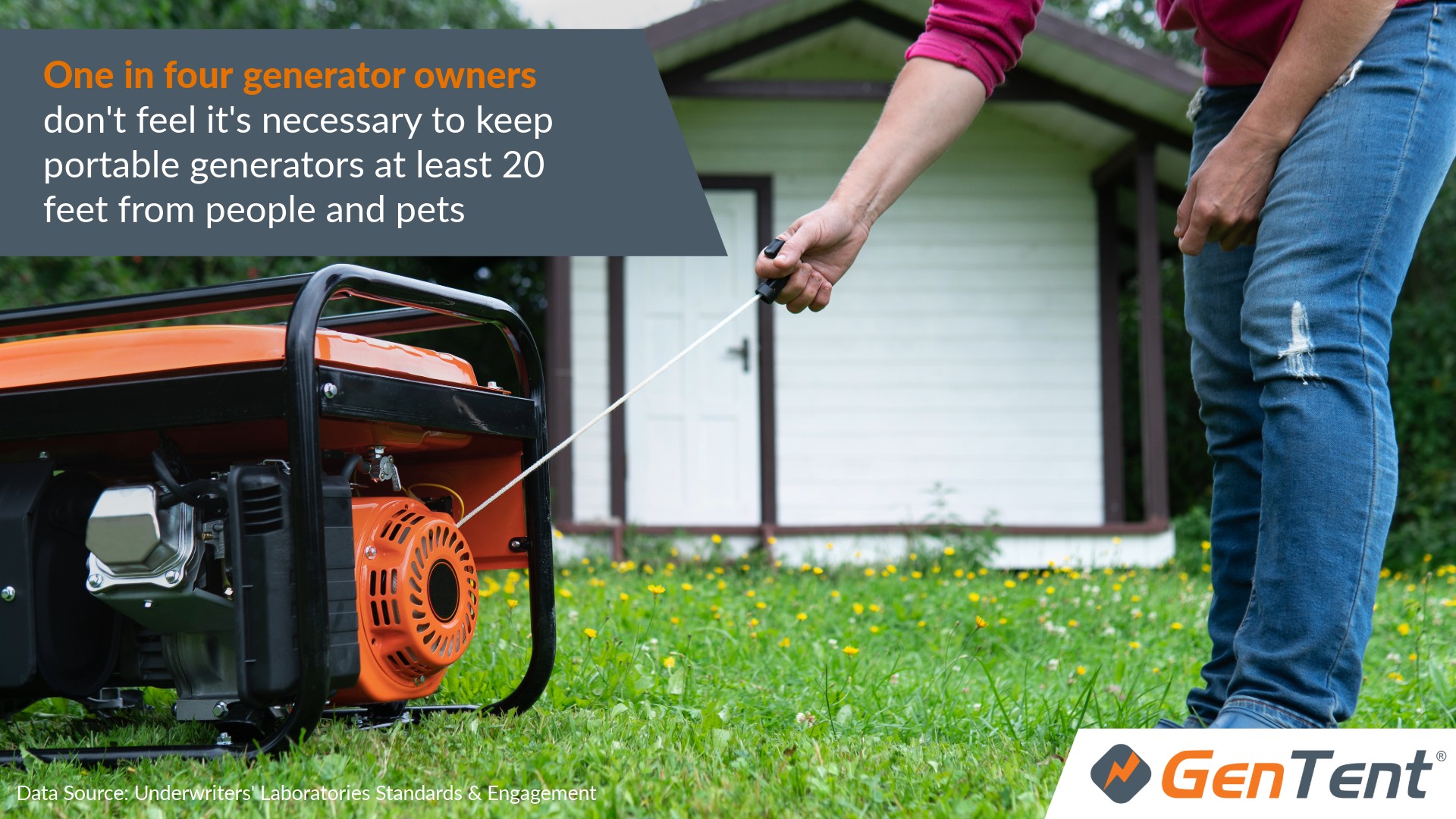
And carbon monoxide is not the only risk when running a portable generator. Exhaust temperatures can reach up to 1,300 °F, which means hot components can ignite nearby materials such as dry leaves, wooden decks, or spilled fuel. According to FEMA, the National Fire Protection Association (NFPA), and the U.S. Fire Administration (USFA), placing generators at least 20 feet away from buildings and combustible materials is essential to prevent fire hazards as well as carbon monoxide buildup.
Recent updates to emissions and design standards are making this safe distance even more important. For example, the UL 2201 and PGMA G300 standards encourage low CO emissions through technologies like electronic fuel injection (EFI) and three-way catalysts—innovations that can push exhaust and engine temperatures above 1,000 °F. While these systems cut carbon monoxide output, they also elevate fire risk if the generator is too near combustible surfaces. Safety professionals are now urging users to follow the 20-foot clearance rule and also clear surrounding debris and fuel storage to avoid both CO poisoning and fire ignition. It is also advised to keep flammable materials such as plywood, pop-up tents, and even non-fire retardant generator running covers away from generators while they are operating due to associated fire hazards.
The 20-foot rule protects against both invisible gas and visible flame.
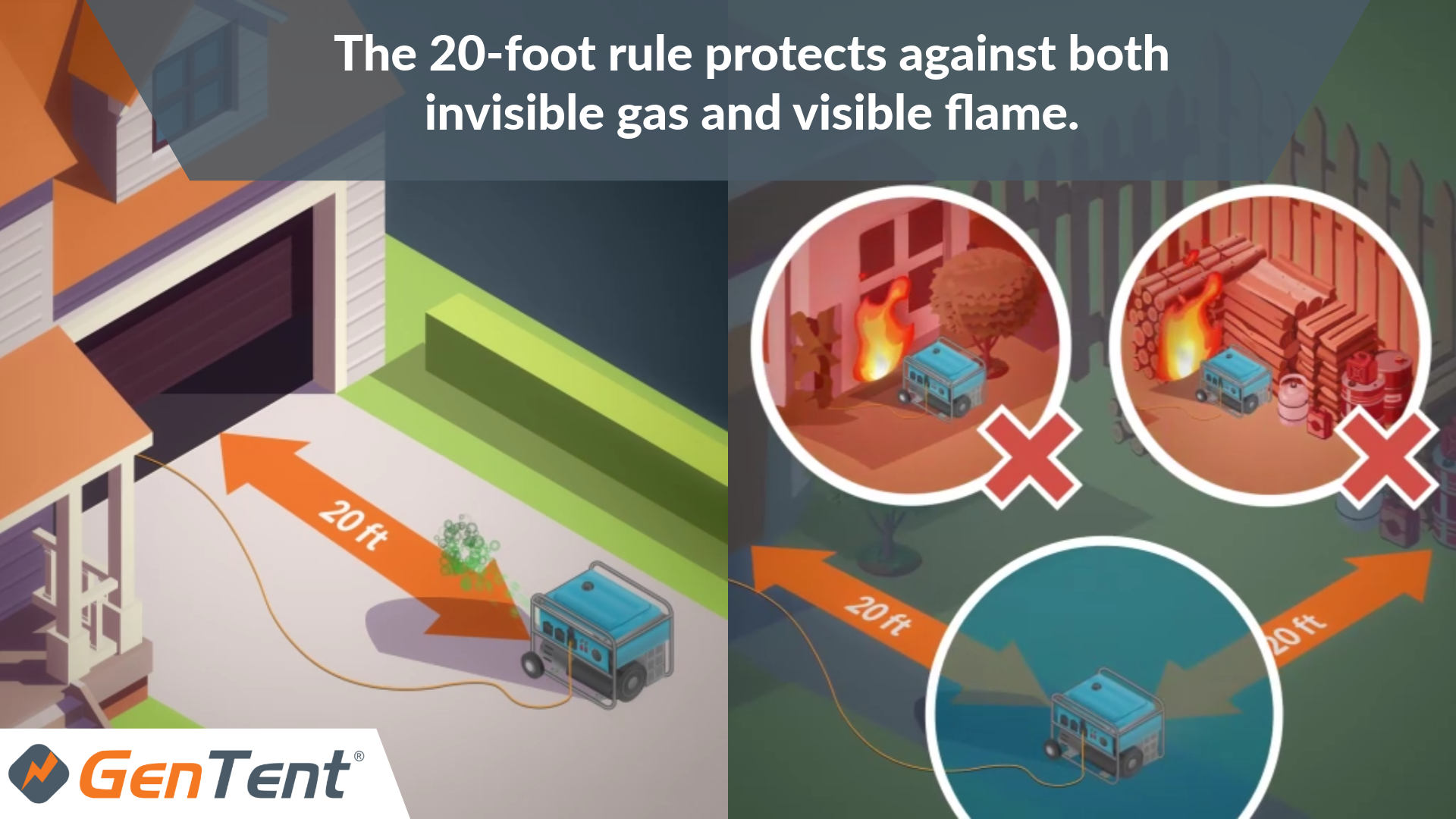
The Deadly CO Risk of Running a Generator Too Close
Running a generator near your home is like leaving a hundred cars running in a closed garage. The carbon monoxide builds up quickly, and you may not notice until it's too late.
Common symptoms of carbon monoxide poisoning include:
- Headaches
- Dizziness
- Nausea
- Confusion
- Shortness of breath
- Loss of consciousness
According to the U.S. Consumer Product Safety Commission (CPSC), carbon monoxide poisoning is responsible for over 400 deaths and 20,000 emergency room visits annually in the United States.
What Generator Manufacturers Are Doing to Help: Automatic CO Shutoff Sensors
In recent years, generator manufacturers have taken important steps to help reduce the risk of carbon monoxide poisoning. Many newer portable generators now include automatic CO shutoff technology. This safety feature is designed to detect high levels of carbon monoxide around the generator and shut the unit down automatically before levels reach a dangerous point.
These updates are based on the Portable Generator Manufacturers’ Association (PGMA) G300 standard, a safety guideline created to help prevent CO-related deaths. The G300 standard requires that generators sold in the U.S. include built-in sensors that monitor ambient CO levels and trigger an automatic shutdown when unsafe levels are detected.
While this is a major improvement in generator safety, it is not a substitute for proper generator placement. Here’s why:
- CO sensors may not detect gas drifting into the home through windows or doors.
- Shutoff features do not eliminate all risk—especially if the generator is restarted while still in a dangerous location.
- Sensors focus on external exposure, not what's happening inside your house where your family may be sleeping.
According to the Consumer Product Safety Commission (CPSC), “Even with shutoff technology, generators must still be placed 20 feet away from all doors and windows, with the exhaust directed away from the house.”
The bottom line: automatic shutoff is a helpful backup, but it’s not foolproof. To truly keep your family safe, always place your generator outdoors, at least 20 feet away from your home, and use a weatherproof canopy like GenTent so you can follow safety guidelines in any kind of weather.
One reason people place generators too close to their homes is bad weather. No one wants to leave a generator out in the rain or snow, so they put it on the porch or in a garage—which creates a serious risk.
GenTent Safety Canopies solve this problem. GenTent is a weatherproof canopy that attaches directly to your generator, allowing you to run it safely outdoors; even in heavy rain, snow, or wind. Unlike other generator running covers, each GenTent canopy is made from NFPA 701-rated flame-retardant materials, providing an extra layer of protection by reducing fire risk during operation.
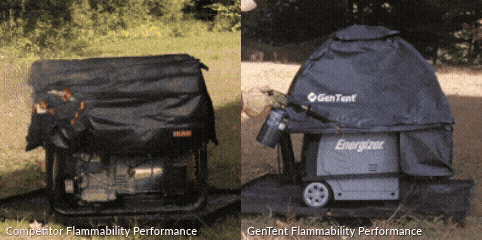
Benefits of using GenTent:
✅ Keeps generator dry in storms and wet conditions
✅ Maintains airflow for safe engine operation
✅ Supports the 20-foot rule—no need to bring it close to shelter
✅ Prevents water from damaging outlets and electronics
✅ Reduces fire risk with flame-retardant construction
✅ Makes following safety rules easy and convenient
With GenTent, you don’t need to choose between safety and functionality. You can keep your generator where it belongs: outdoors and far from your home.
To find the right GenTent for your generator, try GenTent’s Advanced Fit Finder.
Generator Safety Checklist
Before you start your generator, run through this safety checklist:
✅ Place generator at least 20 feet away from all structures
✅ Point exhaust away from the home
✅ Never run it in a garage or enclosed space
✅ Keep it off porches, decks, and near open windows
✅ Clear the area of dry leaves, grass, fuel containers, or other flammable materials
✅ Allow the generator to cool before refueling to prevent fuel ignition
✅ Install battery-powered CO detectors in your home
✅ Use a GenTent Safety Canopy to keep it dry while maintaining airflow
✅ Follow the manufacturer’s instructions every time

Final Thoughts: Distance Saves Lives
Portable generators are a smart way to stay safe and comfortable during power outages; but they can be deadly if used the wrong way. Always place your generator at least 20 feet away from your home, use a carbon monoxide detector, and invest in a GenTent Safety Canopy to keep it dry and functional outdoors. That distance doesn’t just protect you from carbon monoxide, it reduces fire risks. Keeping your generator clear of structures and combustibles is essential.
Carbon monoxide is invisible. Fire can move fast. And during a stressful outage, it’s easy to overlook critical details. Don’t let these hazards sneak up on you; give your generator space, and know what a safe distance truly means. Your life could depend on it.
Ready to protect your family with safe backup power? Explore GenTent’s canopies here.
And always remember: When in doubt, move it 20 feet out!
Trusted Resources for More Information
- NIST: Give Your Generator Some Space
- CDC: Generator Safety Factsheet
- CPSC: Carbon Monoxide Safety Info
- GenTent Safety Canopies

